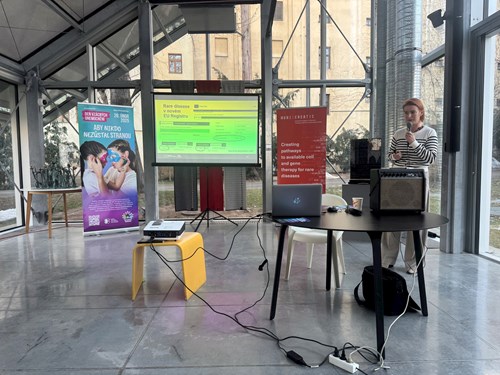
Rare Disease Day – The Importance of Awareness and Connecting Experts with Patients: Leaving No One Behind
Rare Disease Day is a significant event that has, for the past 18 years, drawn attention to the complex journey of patients with rare diseases towards early diagnosis and appropriate treatment. It is observed worldwide every year on 28 February. In the Czech Republic, the number of patients with rare diseases is far from negligible, which is why several events are organised across the country to raise awareness and support these patients.
In Brno, Rare Disease Day is organised annually by the Institute of Medical Genetics and Genomics of the Faculty of Medicine at Masaryk University and the University Hospital Brno. This year, it took place on 24 February at Mendel Greenhouse in the Augustinian Abbey complex. The programme focused on connecting healthcare professionals, patient organisations, and the general public, providing a platform for sharing experiences and knowledge about rare diseases.

The Importance of Awareness in Rare Diseases
According to expert estimates, there are approximately 8,000 known rare diseases today. They are typically characterised by complex diagnostics, a shortage of specialised experts, and limited treatment options. According to Dr Renata Gaillyová, a clinical geneticist from the Institute of Medical Genetics and Genomics at the Faculty of Medicine at Masaryk University and the University Hospital Brno, the main contribution of Rare Disease Day lies in spreading awareness among the public and involving patients in discussions about treatment approaches and research. She emphasises:
"I see Rare Disease Day as an educational event aimed at bringing information to the public about diseases so rare that even specialised doctors, who have worked in the field for decades, may never encounter a patient with such a condition in their entire career."
It is estimated that around half a million people in the Czech Republic suffer from a rare disease. Nevertheless, the path to an accurate diagnosis can be extremely lengthy, sometimes taking several years. According to Professor Šárka Pospíšilová, PhD, Head of the Institute of Medical Genetics and Genomics at the Faculty of Medicine at Masaryk University and the University Hospital Brno, addressing this issue requires not only the involvement of doctors but also scientists and other specialists:
"Patients with rare diseases deserve the attention of doctors, researchers, and other specialists who can help improve diagnostics, treatment, and public awareness of their conditions. This is why our institution has been organising multidisciplinary activities for many years as part of Rare Disease Day, allowing for broad discussions on this topic."
Newborn Screening: A Milestone in Early Diagnosis of Rare Diseases
One of the main themes of this year’s Rare Disease Day was newborn screening, which currently covers 20 different diseases in the Czech Republic. This programme serves as a crucial tool for early diagnosis, which can significantly impact the quality of life of affected patients. Dr Gaillyová highlights its importance:
"It is essential for people to understand that newborn screening can detect diseases even before symptoms appear in a child. This simple test, which involves taking a drop of blood from the newborn’s heel, can reveal serious conditions that, thanks to advances in medicine, are now treatable. In most cases, these are rare diseases, and I call it ‘luck in misfortune’—although the family learns about a serious condition shortly after birth, the inclusion of these diagnoses in screening allows us to initiate treatment immediately and offer the child a good prognosis."
New Diagnoses in Screening: SMA and SCID
In recent years, newborn screening has been expanded to include spinal muscular atrophy (SMA) and severe combined immunodeficiency (SCID). Early detection of SMA enables the introduction of treatments that improve mobility and the overall prognosis of the child, whereas in SCID, early intervention is critical to prevent severe immune system failure.
According to Karolína Pešková, Head of the Diagnostic Laboratories for Inherited Metabolic Disorders at the General University Hospital in Prague, the Czech Republic performs well in newborn screening, and the future will see a stronger focus on genetic testing. She explains:
"The expansion of screening should be done carefully and focus on truly treatable diseases so that parents have clear information and access to appropriate treatment. Discussions about adding new diagnoses and implementing molecular genetic testing in practice are ongoing, and it is very likely that the number of diagnoses included in routine screening will continue to grow."
Gene and Cell Therapies as a Hope for Patients
Advancements in gene and cell therapy are offering increasing hope for patients with rare diseases. The Centre of Excellence CREATIC at the Faculty of Medicine at Masaryk University is dedicated to developing advanced therapies that could fundamentally change the approach to treating various genetically determined conditions in the future.
As Dr Pavlína Danhofer, PhD, Head of the Department of Paediatric Neurology at the University Hospital Brno and the Faculty of Medicine at Masaryk University, explains, genetic diagnostics in paediatric neurology is progressing rapidly, allowing more patients to receive a diagnosis than ever before:
"In paediatric neurology, genetic diagnostics have expanded significantly, meaning that many patients who previously had no diagnosis are now being identified. These are precisely the patients with rare diseases. Once we diagnose them, we begin searching for treatment options. Treatment possibilities are often limited, typically involving only a handful of patients worldwide. In such cases, we collaborate with CREATIC. If we know the relevant gene, we contact CREATIC, and they conduct a thorough search to determine where in the world relevant studies are available and whether the patient can participate. Sometimes, patients travel abroad for treatment, secure sponsors, or organise national fundraising campaigns."
Connecting Research with Clinical Practice
Collaboration between doctors, research centres, and patient organisations is essential for faster diagnostics and access to innovative therapies. However, research and the development of new treatment methods require significant financial and organisational resources. This highlights the growing importance of international cooperation, knowledge sharing, and the unification of criteria to accurately describe, monitor, and target rare diseases for effective treatment.
"The future of treatment lies in standardisation. If we can identify the faulty gene, we can develop an adenoviral vector, prepare gene therapy, and administer patient-specific treatment tailored to their genetic defect," Danhofer adds.
The Role of Patient Organisations
Patient organisations remain key partners for medical professionals and research centres. Their role is not only to represent patients in discussions with institutions but also to provide information, share experiences, and offer mutual support to families facing the challenges of a rare disease diagnosis. The Czech Association for Rare Diseases (ČAVO) represents many smaller patient groups as well as individuals with ultra-rare diseases.
According to Anna Arellanesová, a representative of ČAVO, it is crucial to push for systemic changes that can improve access to specialised care and ensure sustainable funding for treatments:
"When you talk to these families and hear their stories, you can’t help but wish for faster progress in systemic changes, so that patients receive the care and treatment they need, and there is enough capacity among specialists."
A great source of hope is the emergence of clinics for undiagnosed children, which assist families in obtaining a correct diagnosis. Such clinics already exist in Prague and Brno.
"We welcome the establishment of clinics for undiagnosed children, as they are extremely necessary. These clinics work closely with families and help them find the right diagnosis, which is amazing, and we are very grateful for it. We are also thankful for the research conducted by CREATIC because rare disease research has long been overlooked, despite its great importance," adds Arellanesová.
Patient Workshop: The Active Role of Patient Representatives in Clinical Trials
The event concluded with a patient workshop organised by the Centre of Excellence CREATIC at the Faculty of Medicine at Masaryk University, offering participants insights into how patients can engage in clinical trials not only as participants but also as patient advocates. Discussions also covered ways in which patients can contribute to improving clinical trials to better reflect their needs and bring real benefits to the patient community.
Pharmacist Lenka Součková, European Correspondent for ECRIN, explains:
"Our goal is to enhance patient care. In collaboration with the Large Research Infrastructure CZECRIN, we involve patients in clinical trials. Key information sources include clinical trial registries, which are compiled on a platform meeting WHO criteria. Patients can access both completed trials and those currently open for enrolment."










